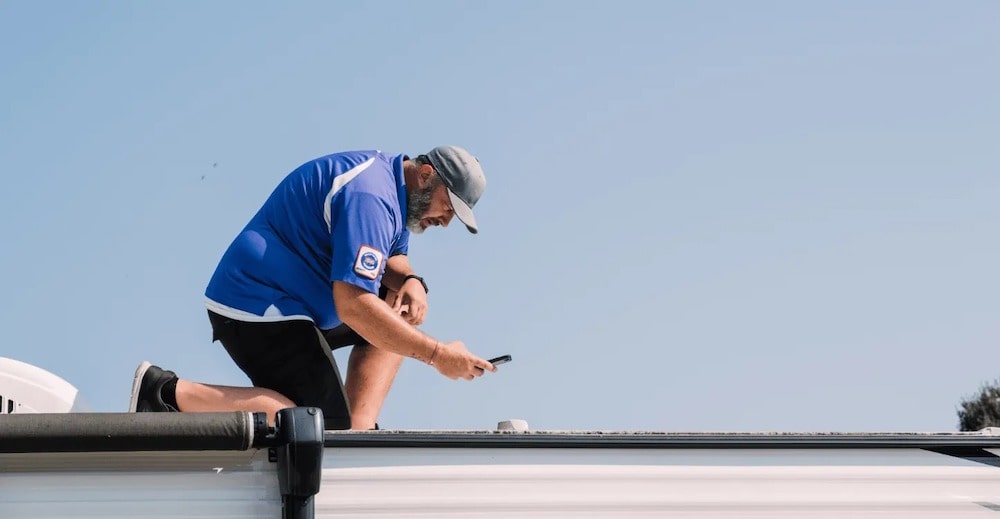Thanks for your support! If you make a purchase using our links in this article, we may make a commission. And, as an Amazon Associate, I earn from qualifying purchases. See the full disclosure here.
We’ve mentioned before how vital an inspection checklist is in our important questions to ask when buying a new or used travel trailer, but many of our readers have had a hard time trying to find a good checklist. So, after hearing your concerns, we put our heads together and created our own RV Inspection Checklist.
Our RV Inspection Checklist is comprehensive and can be used for new and used motorhomes or towable RVs. We have 4 major categories with corresponding subcategories. Here’s the breakdown of items to inspect when you are purchasing a new or used RV.
- The Importance of RV Inspections
- Come Prepared to Conduct an RV Self Inspection
- What Does an RV Inspection Consist Of?
- RV Inspection Checklist
- I. Inspecting the RV Nervous System
- II. Exterior RV Inspection Items
- III. Interior RV Inspection Items
- IV. Inspect the RV Paperwork
- Should I Buy an Extended Warranty for My RV?
- Conclusion: Getting A Professional RV Inspection
- PRO TIP:
- Related Reading:
- About the Author:
The Importance of RV Inspections
One of the big myths concerning RVs is the belief that lemon laws apply to RVs. The closest example to the truth resides in the state of Florida. The lemon laws may apply if a motorhome has the same recurring problem to its AUTOMOTIVE components. Since Lemon Laws typically apply to the automotive parts of your RV, and not the living and storage areas, completing an RV inspection with a checklist is crucial, especially if you’re buying a pre-owned unit.
Every reputable RV manufacturer inspects their products before they leave the factory. The best RV dealers conduct their own PDI (pre-delivery inspection) when the coach hits their lot for the first time and right before it leaves with a customer. Unfortunately, things sometimes get missed.
Inspecting the RV you’re planning on purchasing allows you to learn about potential problems or the general condition of the specific coach. For example, the model you’re buying may have won awards from media authorities like RV Magazine, Trailer Life, or others, but that doesn’t mean someone didn’t tighten a screw correctly.
Once you leave the RV dealership with your RV, any problems that arise become your headache. The issue may be under warranty, but the time it takes for the service department to get the part from the manufacturer, repaired, and ready for you to pick up can take weeks or months in rare cases.
Come Prepared to Conduct an RV Self Inspection
After you’ve walked through the many different options and narrowed down your choices to your top two or three, this is the time to pull out your inspection tool kit. A proper self-inspection should take a couple of hours. The private seller or RV dealership will know how serious of a buyer you are when you request to complete an inspection and shouldn’t have a problem with it.
Read through the list ahead of time. Some of the tests take time to perform. For example, the refrigerator test and the air conditioner need about 20-30 minutes to get a good reading, so you want to set these up first while you’re working through the rest of the list.
The DOT (Department of Transportation) lighting tests require connection to a tow vehicle, and the holding tank test needs a safe place to dump the tanks. You can combine the road test with the holding tank test by driving to a dump station, making your testing process efficient. Use websites like RV Dumps or Sanidump to locate dump stations nearby.
Here is a list of everything you’ll need. Most of which you should have lying around your home. Some more specialized tools are very affordable and easy to purchase at Walmart or your local hardware store.
- A screwdriver with multiple head bits (flat and Phillips)
- A can of WD-40
- Needlenose pliers
- Tire pressure gauge
- Small flashlight
- Electric outlet tester
- USB charger station tester
- Multimeter
- Liquid soap (or food coloring), water, dixie cup, wooden stir
- Empty gallon milk jug
- Calculator
- The checklist
- 2-3 pens of different colors
What Does an RV Inspection Consist Of?
Your inspection is primarily visual. You’ll need the screwdriver and flashlight to open panels to look over the various arterial structures like plumbing, electrical, and other components. Don’t be concerned about breaking anything; these panels are there for easy access to essential parts.
The water and food coloring make it easy to identify leaks. Choosing bright colors will quickly show you the path of the water leak. Stay away from red dyes since they are the worst stains to clean. Use soapy water when possible to avoid the stain issue, but if you have concerns about finding the path of a leak, food coloring works best.
The electric outlet testers will identify if there are any weaknesses in the electric system. In an RV, you’re dealing with both an AC (alternate current) and a DC (direct current) system. Consult the owner’s manuals for each tool, so you know how to use them properly.
You’ll want two or three different color pens for your notes. There are various methods, but you’ll want to have a notation system to help you identify more critical issues than others. For example, a red pen can signify vital issues, blue for relative concern problems, and black for non-issues.
RV Inspection Checklist
I. Inspecting the RV Nervous System
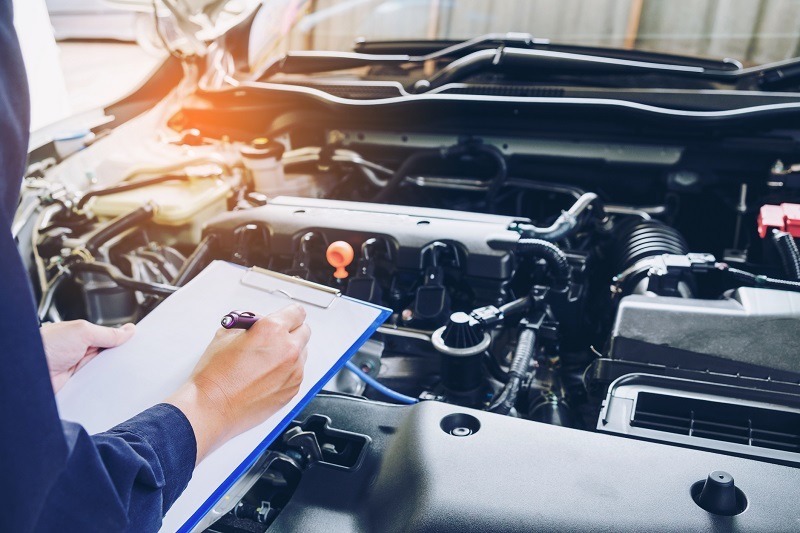
A. RV Engine and Generator Inspection
- (Motorhome) Engine Battery: Check the engine’s battery for a healthy charge and condition. If it’s lead-acid, make sure the liquid in the battery is full.
- (Motorhome) Automotive Fuses: Look over the automotive fuses for burning, melting, or breakage. Notate which fuses need replacement.
- (Motorhome) Rubber Components: Look over the belts, gaskets, and other rubber components for excessive wear. Replace any bad parts.
- (Motorhome) Fluids: Write down the current levels of automotive fluids:
- Engine Oil: Find the date of the last oil change and notate it. Write down the current levels of each. If you’re buying the RV, a good practice is to get a complete oil change service to start with fresh oil once you take delivery.
- Brake Fluid (Yellow)
- Transmission Fluid (Red)
- Jack Fluid (All-Purpose ATF Transmission fluid: Red, or hydraulic fluid: clear or honey-colored)
- Power steering fluid (Red and sweet smell)
- Radiator/Antifreeze Coolant (Green)
- Windshield wiper fluid (Blue, Green, or Orange)
- (Motorhome) Generator Oil: Locate the date of the last oil change for the generator and check the current fluid level
- (Motorhome) Generator Spark Plug: Use the multimeter to check the spark plug. Notate any misfiring issues or replacement concerns.
- (Motorhome) Generator Overall Health: Use the flashlight to look over the generator parts. Notate any evidence of excessive wear, insulation problems, etc.
- (Motorhome) Startup the engine: Notate hesitations, weird sounds, or other strange items. Let it idle for a few minutes before you turn it off. Don’t turn on the generator. You want to listen to the main engine only.
- (Motorhome) Startup the generator: Turn off the main engine so that you can focus on the generator. Notate hesitations, odd sounds, or other strange items. As it runs, turn on various electric things inside the coach. The goal is to see if it matches its wattage rating. When one of the breakers pops, notate, the devices turned on to calculate the wattage later. Use a wattage table to help you figure out usage.
B. Electrical Items to Check During Your RV Inspection
- House Batteries: Check the house batteries for good power levels and overall condition with the multimeter
- Coach Fuses and Breakers: Inspect the AC and DC coach breakers for melting, burning, or breaking. Notate the date you replaced any fuses. Make sure you’re using the correct automotive fuses. American fuses are the rectangular style, and the European version has round edges. The fuses aren’t interchangeable.
- Electric Converter: Locate the electric converter and check it for irregularities. The converter turns your shore power into DC power. Look under or near your refrigerator behind cabinetry. You’ll probably have to pull out kitchen drawers to find it. When it’s working, it’ll make a slight fan noise and may warm up a bit. Make sure you check the device’s internal fuse.
- Electric Inverter: (If applicable) Locate the electrical inverter(s) for proper operation. Inverters turn DC power into AC. If the manufacturer provided the device, it could be located in an external storage bay or under cabinetry. Like the converter, you’ll listen for a good fan hum and a slight temperature rise. If the device is too hot, that means it’s working too hard. Residential refrigerators may have a separate inverter.
- Solar Panel System: (if applicable) Before you test the solar system, talk with the owner about how it’s connected. Use the multimeter on the voltage setting to check the connections. Solar panels don’t turn off, so be careful when testing the connections to see if they’re producing power.
Follow the system through at each connection point with your multimeter to test for power efficiency. Notate any oxidation (green colored corrosion) or other corrosion on the wiring that can hamper the electrical flow. Check the meter inside the RV to compare your readings for accuracy; they should match.
- Electric Outlets: Use the outlet tester on every 110v, USB ports, and DC outlet. Test the grounded outlets by pushing the reset button and turning it back on. Notate any outlets of concern.
- (Motorhome) DOT Lights: Check the headlights, turn signals, clearance lights, reflectors, and other lights. Notate any burnt-out lights and replace them. Use the multimeter on those new lights that won’t come on when activated to determine if it’s a faulty circuit.
- Exterior and Interior Lights: Turn all coach lights on and off, making sure they work. If they don’t, use your multimeter to see if the lighting fixture is receiving power. If not, it may be the circuit or the fuse.
- Backup Camera: (If applicable) Check the operation of the backup camera. If the camera was installed on a towable RV, ask and notate how the previous owner wired it into the RV. There’s more than one way to do it.
- Refrigerator & Entertainment System: Turn on all of the appliances. For the refrigerator, fill two paper cups with water and put a thermometer in each cup. Place one cup in the freezer and the other in the main refrigerator. Come back at the end of the inspection to see if there is a temperature difference. Do the same for the outdoor kitchen if applicable.
- Air Conditioning Effectiveness: Turn the A/C on and down to the lowest setting. Set up a room thermometer in the front and back of the RV. Take a reading of the current temperature. After 20- 30 minutes, take a new reading. Compare the reading to what you set the RV temperature control. They should line up.
- Furnace: Allow the RV to return to the outside temperature. Turn the furnace on (make sure the propane tank is open if the furnace runs on LP). Place an ambient thermometer in the front and rear of the RV. Notate the readings. Come back 20- 30 minutes later and notate the new readings. They should line up with the thermostat setting.
- Central Vacuum: (if applicable) Activate the vacuum system and test the suction by using some ripped-up paper. Turn off the device and open up the collection component. Clean or replace the filters. Check the gasket seals for damage. Look for any hair or debris that may hinder suction in the motor.
- Electric Power Cord: The shore power cord connects securely to the RV. The male/female connections don’t show signs of burning or melting. The cord fits nicely into the RV. The protective shielding doesn’t expose any of the internal wiring
C. Water Lines
- Water Lines: The water lines use color-coated PEX piping. You’ll see blue (cold), red (hot), and white (either) flexible tubing. Make sure they have a soft, pliable feel to them. Replace any lines that are dry and cracked.
- Water Pump: Make sure there is fresh water in the holding tank. Disconnect the RV from the shoreline. Turn on any faucet. You want to see a steady stream of water. You may hear the pump working. That’s okay as long as it doesn’t sound like it’s straining hard. The pump will turn on and off with the faucet.
- Water Feature Leak Check: use soapy water or food coloring to check the seams on the following features. Focus your attention on the seams of the drain and outer perimeter of the component.
- Kitchen sink
- Outdoor kitchen sink
- Bathroom sink
- Shower
- Exterior shower
- Commode
- Dishwasher
- Washer and Dryer
D. Propane
- Propane Lines: Check the propane lines for leaks. Open the tanks and rub soapy water over the lines. If you see any bubbling, that could be evidence of a leak.
- Propane Mounts: Make sure the propane tanks sit securely in their positions and are held securely in place.
- Propane Tanks: Make a note to yourself on the size of the removable tanks. If you’re buying a used RV, go to your local Walmart or hardware store and replace them with fresh tanks instead of refilling the old ones.
- (Motorhome) Permanent Propane Tanks: Inspect the built-in tank for any non-surface rusting, loose connections, or other issues that will compromise the tank. Notate if you smell the gas.
- (Motorhome) Propane Gauge: On your test drive, stop at a propane fill station and add a small amount to determine that the gauge works accurately
E. Holding Tanks
- Fresh Water Holding Tank: Disconnect the shore water line, Drain the freshwater tank, and partially refill it. Look for any leaks. Make sure the valves and lines are in good order. Once the RV is yours, it’s a good idea to sanitize the freshwater tank, but look at, taste, and smell the water from the faucet to see if there’s a significant contamination issue in the tank.
- Grey Water Holding Tank: Find out if the grey tank is empty first. Open and close the sewer release valve to make sure it works well. Pour one or two milk gallon jugs of water down the sink or bathroom sink. Check the sewer release valve area for leaking.
- Black Water Holding Tank: Make sure the black tank is empty first. Check the release valve for proper operation. Pour a gallon or two of water down the commode. Check the sewer release valve area for leaking.
- Black Tank Flush System: Hook up a garden hose to the flush system and run it for a minute or two. Make sure you’re running this test at a safe dump station. Never run the flush system while the black tank is closed. If you hear abnormal sounds, the sprayer may no longer work.
- City Water Connection: The shore water connection looks secure and undamaged
II. Exterior RV Inspection Items
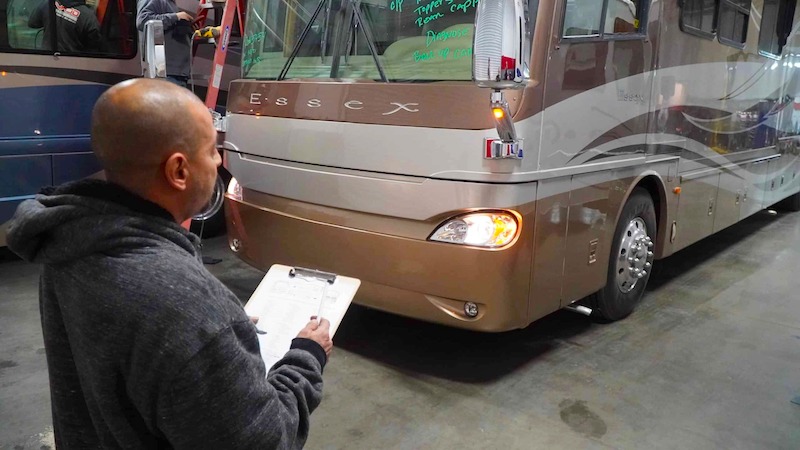
F. Exterior Shell
- Sidewalls: Used RVs may have tiny knicks or dents. You want to look for cracks, open seals, or other loss of integrity that allows moisture through. Discoloration could be mold, mildew, or other contaminants forming.
- Front Cap/Rock guards: Notate any cracks, open seals, or issues of concern.
- (Motorhome) Hood Panel/Generator Bay: Make sure the panel or bay opens and closes smoothly. When closed, there aren’t any gaps due to misalignment.
- Windshield/Front bay window: The window shouldn’t have any cracks or open seals. Single pane motorhome windshields have an average cost of $10,000. RV insurance does not fully cover replacement. There are liquid sealers to fix small spider cracks.
- Back Cap: Notate any issues of concern like cracks, open seals, or other problems
- Roof Ladder: Check that the ladder is secure against the RV. Inspect the connections for open seals that will let moisture through. A layer of silicone caulk will fix this problem.
- Entry Steps: Open and close all entry steps. Older style steps that fold out from the chassis may need a shot of WD-40 to loosen the pivot points.
- (Motorhome) Motorized Steps: The entry steps should deploy every time the door opens. There should be a toggle switch near the door that keeps them deployed when your camping. Notate any problems with either system not working correctly.
- Awning: Open and close the awning. Older manual awning arms can warp with age, making folding up difficult. Inspect the fabric for significant rips or mold growth. Check the installed LED lighting for shorted-out lights.
G. Storage and Utility Bays
The RV has many doors besides the entry door. Check each of them for many of the common problems. Make a note next to the door that needs attention.
- Entry Doors
- Exterior Shower Door
- Fuel Door
- Fresh water fill
- Furnace Door
- Water heater
- Refrigerator Panels
- Clothes dryer exhaust vent
- Stove hood exhaust vent
- Open and Close: Make sure the doors open and close securely. They’re not off-center, and the hinges work well.
- Doors Stay Open: If the bay doors have struts or other mechanisms that keep them open, make sure they work correctly. Older RVs won’t have friction hinge doors.
- Latching System is Secure: The handles and locks aren’t loose or falling apart.
- Weather Seals are Maintained: The weatherstripping should be soft and pliable to create a good seal against the bay door. Use a rubber treatment spray at least 2-3 times a year. Replace dry and cracked stripping.
- Bay Lighting: Lights inside the bay work. The RV may have a master switch that turns off all the power to the lighting in the bays to prevent them from turning on while traveling.
- Damage Concerns: Look for evidence of damage due to water, pests, or other issues
H. Roof and Air Conditioner
- Roof Integrity: There isn’t any soft spots or dry rot on the roof
- Open Seals: All seals are solid or fixed with caulk
- Vent Covers: All vent covers fit nicely over the openings, aren’t cracked, and work properly
- Satellites and Antennas: All wireless inputs rotate, deploy, and fit into their cradles properly. None of the wiring is exposed or degraded.
- Air Conditioner: Start the A/C at the beginning of the inspection to give the compressor time to cool down. After 10-15 minutes, turn it off so you can open it up safely.
- Shroud: The protective cover is in good shape and secures well
- Seals: There aren’t any openings in the caulking around the A/C unit
- Wiring: There isn’t any exposed wiring outside the shroud. None of the wires inside the unit is loose or lost parts of its coating
- Intake: The intake is clean of dirt and other contaminants
- Coils: The coils are intact and straight. There are tools to straighten them out.
- Insulation: The insulation within the unit is in good shape
- Filter: A/C filters will need replacement, but there is evidence of regular filter usage.
- Compressor: The compressor is cold to the touch. It will make noise when working. If the compressor doesn’t work, it may be cost-prohibitive to replace the part.
- Fan: The fan should spin well with your finger.
I. Hitch
- Rear Receiver: The receiver is in good shape, and the electronic connector is 7-pin (modern). There are adapters available if you have a 5 or 6 pin.
- Front Hitch/ Kingpin: The towable hitch isn’t significantly dented and may show surface rusting only
- Safety Chains: All safety chains are in place, and it’s in good working order. The law requires that safety chains are connected while traveling.
- Sway Bars: Sway control equipment looks good and operates well
- Tongue Jack: The tongue jack operates well. If it’s manual, you’ve located the cranking tool, and it’s in good repair. If electronic, the system powers up and operates when you activate it with the switches.
- Umbilical Cord: The electric cord that attaches to the tow vehicle is in good shape. Wires are not exposed, and none of the prongs are bent. Plug the umbilical cord into a running tow vehicle to test the DOT lights. All lighting should light up when you activate the tow vehicle’s lights.
- Brake Lights
- Left Turn Signal
- Right Turn Signal
- Hazard Lights
- Reverse Lights
- (if applicable) Back-Up Camera Activates
- Headlights and Clearance Lights
J. Slideouts
- Slideout Function: All slideouts deploy and retract smoothly on their tracks
- Manual Slideout Retractor: (if applicable) You’ve identified the manual slideout retraction port and tool. Manual retraction devices started showing up in the RV industry around the 2019-2020 model years. Many manufacturers place the device under the main entry door.
- Slideout Awnings: The slideout awnings roll easily when deployed. You may want to climb on the roof to get a “birds-eye” view to check for any tearing or mildew growth.
- Slideout Windows: The windows on the slideouts look good, and the weather stripping keeps its seal against the window. Perimeter seals don’t have any gaps.
- Slideout Seals: Make sure the rubber weather seals are soft and pliable. The stripping needs to form a tight seal against the slideout. There are spray rubber conditioners to bring them back, but you may have to replace them if they are severely dry.
K. Wheels and Underbelly
- Tires: The tires have the correct air pressure (PSI), and there aren’t any soft spots that indicate signs of decay. If you do need to replace the tires, there are discount programs through camping clubs like Escapees.
- Rims: The rims look good around the edges. Axles and ball bearings need to be regreased yearly during a preventive maintenance regime for towables. Pop-up campers may need this every six months. There will be a small tube to inject the grease through.
- Brakes and Pads: The brakes and pads are in good working order, and the pads are still thick enough to perform well. There isn’t irregular wear or scoring on the pads.
- Suspension: The components of the suspension are in good shape and only have surface rusting
- Axles: The axles aren’t bent and are tight in place. If the axles bow upwards, that means a previous owner overloaded the travel trailer beyond its gross vehicle weight rating much of the time. The axles need replacement; it’s not a repairable issue.
- Underbelly: (if applicable) The corrugated composite material under the RV isn’t torn, cut, or open. Denting due to road debris is expected. If the used RV you’re inspecting comes from a time before the underbelly was sealed, check for any damage to the components, including automotive parts, if you’re looking at a motorhome.
L. Stabilizer Jacks
- Stabilizer Jack Functionality: The jacks deploy and fold in smoothly. Manual versions come with the cranking tool and don’t lock up in a partial position. Electronic systems don’t lag when activating the toggle switch. The jacks are tight against the RV
- (Motorhomes & Luxury Towables) Auto-Level: The auto-level feature works well and has a good accuracy
- (Motorhome) Jack Fluid: When fully extended, the hydraulic jacks don’t leak fluid after 20-30 minutes. This is due to a faulty internal gasket. You can use an all-purpose transmission fluid to replace the jack fluid.
III. Interior RV Inspection Items
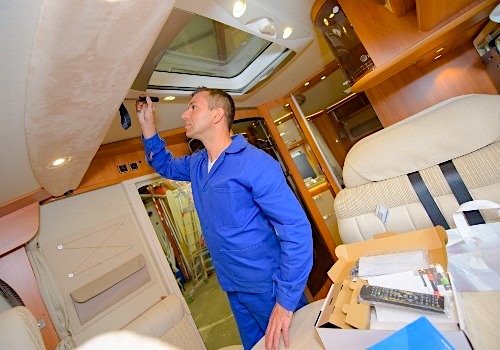
M. Ceiling
- Ceiling Condition: The ceiling doesn’t show any evidence of staining, leaking, or damage
- Molding: All of the molding trim is in good shape, secure, and original
- Ceiling Decoration: Mirrors, LED lighting, and other aesthetics look good and don’t need any repair
- Fans, Sunroofs, and Vents: Ceiling and vent fans are in good working order. Vent screens aren’t ripped and clean. Vent covers open and close. Sunroofs aren’t cracked or leaking. All seals are secure.
- Air Conditioner Vents: All A/C vents are in place and work. Shine your flashlight inside for evidence of significant levels of contaminants
N. Flooring
- Flooring Condition: The vinyl or carpet doesn’t have any loose spots or missing sections. The carpet is whole and clean. The flooring is original, or the new flooring looks complete.
- Heat Ducting: Heat duct grills are in place and function. Shine your flashlight inside to look for a significant level of dust, mold, mildew, or other foreign material.
O. Windows
- Window Treatments: The window treatments are original, in good repair, and none are missing
- Window Shades: All shades function and are in great shape.
- Seals: The rubber seals haven’t shrunk and are in place. You don’t feel any air or temperature difference on the seal itself.
- Frameless Windows: (If applicable) The weatherstripping forms a good seal against the windows and its pliable
- Window Function: The windows are all in their tracks and slide smoothly to open
- Window Integrity: None of the windows are broken, cracked, or in need of repair. If they use mechanisms to open, all of the components are in good working order
P. Walls, Cabinetry, and Dashboard
- Interior Walls: The inside walls are in good condition, don’t show signs of water damage, and the wallpaper isn’t coming loose. The wallpaper tape is in place, and everything is original.
- Cabinetry: All of the cabinets are in place and look good. Hinges and struts work. Doors match, and there aren’t any missing hardware pieces. The cabinets aren’t loose, and you don’t see signs of wood stress.
- Cabinet Seals: The caulking between the wall and cabinets looks good, and you don’t see any gaps
- Drawers: None of the drawers are off their tracks, and they aren’t falling apart. All drawers pull out smoothly.
- Privacy Doors and Accordion Walls: All privacy components, including curtains, are on their tracks and slide well. They aren’t missing parts, and they lock in place easily.
- Deterioration: There isn’t any evidence of mold, mildew, pest, or other loss of structural integrity
- (Motorhome) Dashboard: The dashboard is secure in place. All of the gauges work accurately. The instrument panel lights up when the headlights are on.
- (Motorhome) Instrument Panel Function: Take a few minutes to learn all of the functions in the driver’s area. Test each one to verify it works
- Back-Up Camera Function: (If applicable) Spend some time learning how the camera works. Every model is different. Make sure it does what it’s supposed to do.
Q. Furniture and Driver’s Seats
- Furniture Integrity: All of the furniture pieces are original and in good condition.
- Furniture Mechanics: Folding furniture mechanisms operate smoothly. Metal parts don’t have any rust. Electronic controls function well.
- Master Bed: The platform lifts and stays in place. The mattress is in good condition and comes with the original decorative pillow covers and bedspread.
- Bunk Bed: (If applicable) The mattress is in good condition and original. Extra features like storage pouches, electric outlets, and other features work well. Top bunk ladders are stable
R. Electronics and Kitchen Appliances
- Stove and Oven: The cooking appliance(s) operate normally. Don’t be surprised if the igniter doesn’t work. That component usually doesn’t last too long. You can use a lighter wand to light both the gas stove and oven.
- Microwave: The microwave works and its display reads well.
- RV Control Panel: The functions and level indicators work properly (black holding tank levels may not be accurate due to dirty sensors)
- Water Heater: The sink and shower water is hot after the water heater is on for 5-10 seconds.
- LED Fireplace: All LED lights work, the heating component works, and all of the additional features work.
- Safety Alarms and Equipment: All detectors, the fire extinguisher, and other required safety equipment are in place, tested successfully, and are original or better.
IV. Inspect the RV Paperwork
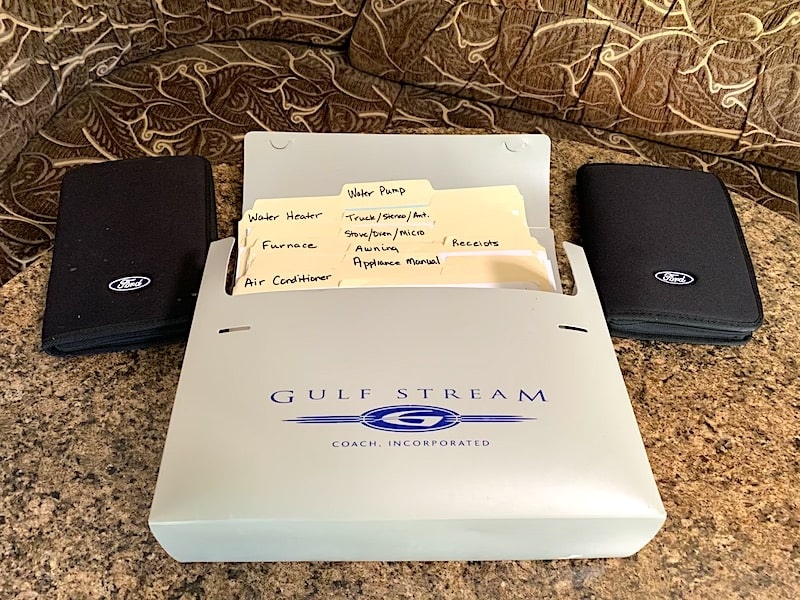
- Manual Binder: The RV document storage holder is available to you.
- Owner’s Manuals: The RV’s main manual and all the individual component documentation are inside.
- Updated Manuals: The owner’s manuals for upgraded/updated devices are in the binder.
- Sales Agreements: The original sales agreement and any other purchase documents are inside the binder.
- Title and Registration: Upon completion of the sale, you’ll receive the original copy of the title that’s clean of any liens or any other legal restrictions. The previous owners have shown you that the registration of the RV is in their name and the vehicle’s details match the information on the registration.
- All Warranty Documents: The binder contains all manufacturer and extended warranty documentation even if it’s expired (insurance companies and some states require these documents).
- Other Documentation: Any other relevant documentation is identified and in the folder
Should I Buy an Extended Warranty for My RV?
Yes – but not from a dealership! Unfortunately, your odds of suffering a major mechanical breakdown go up with every passing year. Based on RV Warranty claims records, more than 3 out of every 10 RVs will need major repairs in only their second year on the road. This skyrockets to 8 out of 10 in their fifth year, and virtually ALL of them in their eighth year! Today’s RVs are increasingly more complex, and with more things to go wrong, the need to protect your investment is more important than ever.
Our RV Warranty plans allow you to change your mind! If you’re looking to sell your RV to a private party, you can absolutely transfer the policy to the new owner. Additionally, if you are trading in your RV, or getting out of RVing altogether, you can cancel your policy for a pro-rated refund.
We bought a warranty through Wholesale Warranties for several reasons:
- We can cancel the warranty at any time and get a pro-rated refund
- We can transfer the warranty to the new owner if we decide to sell our RV
- There are no mileage caps on our policy
- We can use repair shops all across the country
- We can use a mobile repair company right at our campsite
- The price is way better than most dealerships
- We could finance the cost of the warranty
- With parts and labor prices increasing all the time, we have peace of mind
You owe it to yourself to at least check out a warranty and get a free quote to see if it is right for you. It just takes a few minutes and you will learn a ton about protecting your investment. We only recommend products we use ourselves and we highly recommend you get a free quote from Wholesale Warranties.
Conclusion: Getting A Professional RV Inspection
You should assume that you will find some issues, decide what concerns you can live with and what’s too problematic. Based on your skills and real free time, have an idea of what you are willing to fix yourself and what you’ll need a professional RV service technician to fix if you do decide to buy the coach. Also, have a general idea of how backed up the RV service center is or how soon the mobile RV repair company will need to complete the work.
If you don’t have a lot of time or are looking at an expensive luxury RV, hiring a professional RV inspector may be worth it. The National Recreational Vehicle Inspectors Association (NRVIA) trains and certifies RV inspectors across the United States. They even have a searchable database of their graduates. You can use the NRVIA Locator so you can find an inspector close to the RV you’re looking to buy.
These professional inspectors are licensed, bonded, and insured to inspect multimillion-dollar bus conversion Class A motorhomes down to teardrop campers. There’s usually a flat rate for a thorough level one inspection that covers everything in the RV. When they complete their task, they write up a report for you. The level two review sends fluid and other samples to a forensics lab to test for contaminants. A more detailed inspection is more expensive but can be valuable in certain situations.
If you’re looking to buy a new or used RV, we invite you to print this checklist out and take it with you to guide you through your RV inspection. We recommend narrowing your choices down to your favorite three before you inspect them, so you aren’t wasting your time on motorhomes or travel trailers you end up not buying.
PRO TIP:
Even before you decide which RV to buy we highly recommend that you rent the type of RV you are considering purchasing. “Try BEFORE You Buy” is advice we give all the time. Why…?
Because many people buy the wrong type of RV and discover they want to change to a new RV or camper after only a year or two. Since RVs experience most of their depreciation in the first several years you could end up losing a lot of money when you try to sell or trade-in your RV on the “right RV.” For example, if you are considering purchasing a Class C RV, rent one first to see how you like it!
To start your search for your perfect coach, learn the best RV shopping strategies and more through our RVBlogger Website and take a virtual tour through our weekly YouTube walk-throughs. In addition, you can check out our Amazon Gear Page to find the best essential accessories you’ll need to start your RV vacation on the right road to success.
If you want to get inspiration from the RV Community, join the conversation with our RV Camping for Newbies Facebook Group. It won’t take much scrolling to see how we all congratulate each other when someone takes delivery on their newly purchased motorhome or travel trailer. You can also see how we travel on our Instagram page.
Do you know what you want to do, where you want to go, or how you want to use your RV once you get it? Subscribe to our FREE digital magazine, RV Camping Magazine, to learn all that and more. Our guest authors explore the best destinations, show you fascinating remodels and restorations of vintage travel trailers. The National RV Training Academy writes an article and adds a video to customize your RV preventive maintenance checklist each month. You’ll also learn about new gadgets and the best recipes that are RV-friendly.
So, for Mike and Susan, remember to leave your campsite better than you found it, thanks for reading, and we’ll see you next time!
Related Reading:
12 Best Questions to Ask When Buying a New Camper
10 Best Questions to Ask When Buying a Used Camper
Should I Buy an RV or Camper? Here’s How to Decide…
Best RVs and Campers for Beginners
How to Find Cheap RV Rentals Under $100 a Night
About the Author:
Brian Newman – Author and Full Time RVer
Although he’s from Motown, Brian Newman is a legacy RVer that grew up on I-75. He, and his wife have enjoyed the full-time RV lifestyle since 2017.
Like John Madden, he hasn’t “worked” in years because he gets to write about his passion. When he’s not working, he supports his daughter’s dog rescue efforts and disability causes.


